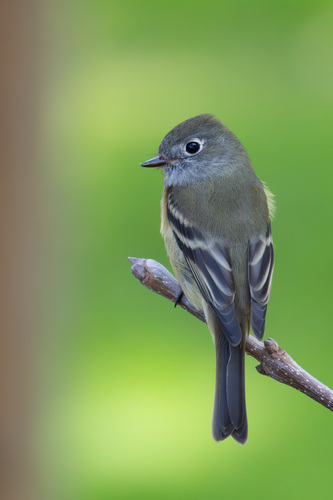
Hammond's Flycatcher
The Hammond's Flycatcher (*Empidonax hammondii*) is a small, migratory songbird that breeds in the coniferous forests of western North America. It is known for its preference for dense, mature forests and its distinctive, almost inaudible song. This flycatcher plays a crucial role in controlling insect populations within its forest habitat. Although not as visually striking as some other flycatchers, its subtle beauty and ecological significance make it a fascinating subject for birdwatchers and researchers alike.
12-14 cm
Length
22-24 cm
Wingspan
Least Concern
Conservation Status
Distribution
Breeds from southeastern Alaska and British Columbia south through the western United States to southern California, and east to Montana and Wyoming. Winters primarily in Mexico and Central America.
Lifespan
Up to 7 years (wild); Captivity: Unknown
Hammond's Flycatcher's Habitat
Habitat Types
Mature coniferous forests, Mixed coniferous-deciduous forests, Riparian woodlands
Climate Zones
Temperate, Boreal
Adaptations
Prefers dense understory and shaded areas within forests, often near water sources. Its plumage provides camouflage in the dappled light of the forest.
Variations
No recognized subspecies, but some subtle plumage variation exists across its range.
Appearance
Breeding Plumage
Breeding plumage is generally brighter, with more contrast between the olive-gray upperparts and the yellowish underparts. Non-breeding plumage is slightly duller.
Seasonal Feather Changes
Minor seasonal variation; primarily related to feather wear.
Sex Based Plumage Differences
Males and females are very similar in appearance, with subtle differences in wing and tail length.
Notable Features
Small size, Short, thin bill, Prominent eye-ring, Two pale wingbars
Diet and Feeding
Primary Foods
Insects, Spiders
Foraging Behavior
Primarily a 'sallying' flycatcher, perching on a branch and making short flights to capture insects in mid-air. Also gleans insects from foliage.
Specializations
Agile flight allows for efficient capture of flying insects. Short, thin bill is well-suited for handling small prey.
Seasonal Diet Variations
Diet remains consistent throughout the year, focusing on available insects. May consume more spiders during certain times of year.
Behavior
Social Structure
Generally solitary or in pairs during the breeding season. May form small, loose flocks during migration.
Communication
Quiet, two-part song ('su-weet'), Sharp 'pip' call notes, Wing flicking
Migration
Nocturnal migrant. Travels long distances between breeding and wintering grounds.
Territorial or Group Behaviors
Males defend breeding territories through song and chases. Territory size varies depending on habitat quality.
Conservation
Threats
Habitat loss (logging, deforestation), Forest fragmentation, Climate change (altered forest ecosystems), Pesticide use (reducing insect prey)
Protection Programs
Sustainable forestry practices, Protected areas (National Parks, Forests), Monitoring programs
Local National Laws
Protected under the Migratory Bird Treaty Act in the United States.
Population Trend
Stable
Population Estimates
Global population estimated at 6.8 million (Partners in Flight)
Interesting Facts
They are often confused with other *Empidonax* flycatchers.
Their similar appearance to Dusky and Gray Flycatchers makes identification challenging.
It is named after William Alexander Hammond
a surgeon general of US army
Their song is very quiet and easily missed.
Unlike many other songbirds, their song is not loud or complex.
Faqs about Hammond's Flycatcher
How can I tell a Hammond's Flycatcher from a Dusky Flycatcher?
Hammond's Flycatchers tend to have a slightly longer primary projection (the length of the wing feathers extending beyond the folded wing) and a slightly darker lower mandible. Habitat preference can also be a clue; Hammond's prefer denser, taller forests.
Where can I see a Hammond's Flycatcher?
Look for them in mature coniferous forests in the western United States and Canada during the breeding season. They are often found near streams or other water sources.
What do they eat?
They eat mostly flying Insects.
Copyright @ Nature Style Limited. All Rights Reserved.
 English
English